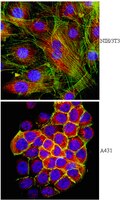Capping protein is essential for cell migration in vivo and for filopodial morphology and dynamics.
Sinnar, SA; Antoku, S; Saffin, JM; Cooper, JA; Halpain, S
Molecular biology of the cell
25
2152-60
2014
Mostrar resumen
Capping protein (CP) binds to barbed ends of growing actin filaments and inhibits elongation. CP is essential for actin-based motility in cell-free systems and in Dictyostelium. Even though CP is believed to be critical for creating the lamellipodial actin structure necessary for protrusion and migration, CP's role in mammalian cell migration has not been directly tested. Moreover, recent studies have suggested that structures besides lamellipodia, including lamella and filopodia, may have unappreciated roles in cell migration. CP has been postulated to be absent from filopodia, and thus its role in filopodial activity has remained unexplored. We report that silencing CP in both cultured mammalian B16F10 cells and in neurons of developing neocortex impaired cell migration. Moreover, we unexpectedly observed that low levels of CP were detectable in the majority of filopodia. CP depletion decreased filopodial length, altered filopodial shape, and reduced filopodial dynamics. Our results support an expansion of the potential roles that CP plays in cell motility by implicating CP in filopodia as well as in lamellipodia, both of which are important for locomotion in many types of migrating cells. | 24829386
 |
Mena/VASP and αII-Spectrin complexes regulate cytoplasmic actin networks in cardiomyocytes and protect from conduction abnormalities and dilated cardiomyopathy.
Benz, PM; Merkel, CJ; Offner, K; Abeßer, M; Ullrich, M; Fischer, T; Bayer, B; Wagner, H; Gambaryan, S; Ursitti, JA; Adham, IM; Linke, WA; Feller, SM; Fleming, I; Renné, T; Frantz, S; Unger, A; Schuh, K
Cell communication and signaling : CCS
11
56
2013
Mostrar resumen
In the heart, cytoplasmic actin networks are thought to have important roles in mechanical support, myofibrillogenesis, and ion channel function. However, subcellular localization of cytoplasmic actin isoforms and proteins involved in the modulation of the cytoplasmic actin networks are elusive. Mena and VASP are important regulators of actin dynamics. Due to the lethal phenotype of mice with combined deficiency in Mena and VASP, however, distinct cardiac roles of the proteins remain speculative. In the present study, we analyzed the physiological functions of Mena and VASP in the heart and also investigated the role of the proteins in the organization of cytoplasmic actin networks.We generated a mouse model, which simultaneously lacks Mena and VASP in the heart. Mena/VASP double-deficiency induced dilated cardiomyopathy and conduction abnormalities. In wild-type mice, Mena and VASP specifically interacted with a distinct αII-Spectrin splice variant (SH3i), which is in cardiomyocytes exclusively localized at Z- and intercalated discs. At Z- and intercalated discs, Mena and β-actin localized to the edges of the sarcomeres, where the thin filaments are anchored. In Mena/VASP double-deficient mice, β-actin networks were disrupted and the integrity of Z- and intercalated discs was markedly impaired.Together, our data suggest that Mena, VASP, and αII-Spectrin assemble cardiac multi-protein complexes, which regulate cytoplasmic actin networks. Conversely, Mena/VASP deficiency results in disrupted β-actin assembly, Z- and intercalated disc malformation, and induces dilated cardiomyopathy and conduction abnormalities. | 23937664
 |










